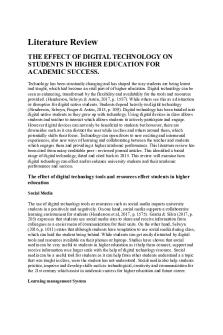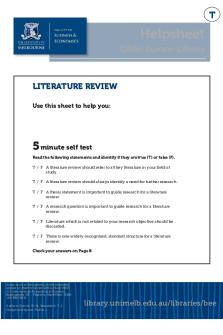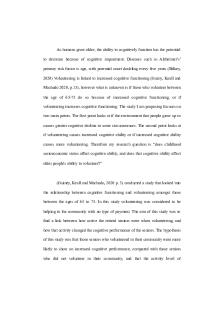Literature Review - Feminist Criticism PDF

| Title | Literature Review - Feminist Criticism |
|---|---|
| Author | ArtsieWolf |
| Course | Reading Course |
| Institution | University of Ontario Institute of Technology |
| Pages | 5 |
| File Size | 89.5 KB |
| File Type | |
| Total Downloads | 32 |
| Total Views | 178 |
Summary
Literature review on feminist criticism. Including abstract...
Description
Literature Review (Feminist Criticism)
1
Abstract The purpose of this study is to explore and learn more about academic scholarship pertaining to visual rhetorical in feminist criticism. The study is concerned with “the ways in which literature (and other cultural productions) reinforce and undermine the economic, political, social, and psychological oppression of women” (Tyson 83). The goal of this review is to study analyze the primary theories, ideas and theorists who have founded and made major contributions towards feminist criticism. Literature Review (Feminist Criticism) Feminist criticism is the ideology that refers to how literature and other factors reinforce the patriarchy and gender roles to further oppress women. The objective of feminist literary criticism is to interpret symbolism of traditional women so it will not be forgotten by men and give a critical response towards the opinion manifested in the literary world. Moreover, feminist criticism is an effort of women scholars and writers to change the tyranny of male oriented views and roles. For example, a male author writing a book that will only apply to men despite the
Literature Review (Feminist Criticism)
2
existence of women, which is also known as androcentrism criticism. One of the most wellknown scholars and writers of feminist criticism is Virginia Woolf. She wrote many essays and novels about feminism. However, scholar Alice Walker argued against Woolf, believing there are many misapprehensions in Woolf’s essay. During Woolf’s time there were not many activists, fortunately at this instance there have many notable scholars and theorists. Lois Tyson is one of those theorists who wrote many theories regarding feminist criticism. These scholars, writers and theorists discuss many theories and ideas regarding feminist criticism. Such as the three wave of feminism. Going into detail about the oppression and injustice against women. Virginia Woolf is rightfully considered to be the founder of feminist criticism. She is one of the most important modernists in the 20th century. In her lifetime, Woolf wrote many essays and novel. She was an ardent feminist at the time when women rights were dismissed. She used her novels and essays to voice her views on the injustice against women. ‘A Room’s of One’s Own’, one of Woolf’s most memorable essays, accomplishes this by depicting women several ways. Using metaphors, the essay explores Woolf’s observations on the social injustices and women’s lack of free expression and speech. Some scholars, such as Alice Walker criticized Woolf’s observations in her essay’ A Room of their Own’. Woolf in her essay mentions that for a woman to compete against men she needs ‘a room of their own’. However, Walker believes her thoughts were false. Using the example provided by in the life of Phillis Wheatly. Wheatley was a black slave who did not even own herself. She wrote poems for herself, making her another striving female writer. As an American black woman herself, Walker is extremely passionate about the freedom and rights in her community.
Literature Review (Feminist Criticism)
3
Lois Tyson, a professor of English at the Grand Valley approaches the number of different theories of feminist criticism. A common theory Tyson discusses is how women are oppressed by the patriarchy in many ways. Economically, politically, socially, and psychologically [Tyson 83]. The ideology is the primary reason to which women are oppressed. Tyson argues that society is so immersed in the patriarchy that we are programmed “not to see the ways women are oppressed by traditional gender roles” (Tyson 86). This is proven in more of the cultural areas where the men promote these traditional gender roles where men must rational and strong. On the contrary women are seen as irrational, emotional, and nurturing creatures. Some scholars, such as Tyson, theorize that feminist criticism follows three waves. The first wave of feminism, taken place in the late 17th-century early 19th-century writers such as Mary Wollstonecraft would highlight the inequality between men and women. For 70 years, the first wavers would advocate for their rights and freedom. Some of the most memorable activists include Susan B. Anthony and Victoria Woodhull. They contributed to the women’s suffrage movement which then lead to the National Universal Suffrage in 1920. Leading to the 19th Amendment to be ratified, allowing more than 8 million women across the United States to vote in elections for the first time. The second wave of feminism, taken place in the early 1960s to the late 1970s builds up on more equal working conditions in America during World War 2. Protests such as the National Organization for Women (NOW) were for to protest the injustice against women. Shortly after, the third wave of feminism began. Taken place in the 1990s to present day women are still fighting for their equal rights. Moreover, the third wave borrows from the post-
Literature Review (Feminist Criticism) structural and contemporary gender and race theories. Scholars such as Alice Walker hope to reconcile feminism within the black community. Gender inequality is a huge issue for women. Feminist criticism does a good job of illustrating the harsh reality in our community from the late 70s to present day. Feminists, such as Lois Tyson and Alice Walker would agree that there are issues that need to be addressed. Gender roles needs to be updated. Women were and are to this day controlled through fear and are taught to act a certain way to appease the patriarchy. All throughout history the society patriarchy works to justify the inequalities between men and women. Feminisms “ultimate goal [is] to change the world by promoting equality” (Tyson 92). Feminist literary criticism interprets the patriarchal society we live in.
4
Literature Review (Feminist Criticism)
5
Reference Feminist literary criticism. The New York Public Library. (n.d.). Retrieved December 12, 2021, from https://www.nypl.org/node/5672. History.com Editors. (2009, October 29). Women's suffrage. History.com. Retrieved December 12, 2021, from https://www.history.com/topics/womens-history/the-fight-for-womenssuffrage. Napikoski, L. (2020, February 6). What is feminist literary criticism? ThoughtCo. Retrieved December 12, 2021, from https://www.thoughtco.com/feminist-literary-criticism-3528960. Purdue Writing Lab. (n.d.). Feminist criticism // purdue writing lab. Purdue Writing Lab. Retrieved December 12, 2021, from https://owl.purdue.edu/owl/subject_specific_writing/writing_in_literature/literary_theory_a nd_schools_of_criticism/feminist_criticism.html. Wikimedia Foundation. (2021, November 26). A room of one's own. Wikipedia. Retrieved December 12, 2021, from https://en.wikipedia.org/wiki/A_Room_of_One %27s_Own#Criticism. Wilcox, B. (2015, July 14). Feminist literary criticism. Medium. Retrieved December 12, 2021, from https://brettwilcox.medium.com/feminist-literary-criticism-229c7719b13a....
Similar Free PDFs

Feminist Criticism on Cinderella
- 2 Pages

Literature Review
- 10 Pages

Literature Review
- 9 Pages

Literature Review
- 6 Pages

Literature Review
- 32 Pages

Literature Review
- 9 Pages

Literature Review
- 5 Pages

Literature Review
- 15 Pages

Literature Review
- 4 Pages

Literature Review
- 16 Pages

Systematic Literature Review
- 9 Pages

Mobile Learning Literature Review
- 26 Pages
Popular Institutions
- Tinajero National High School - Annex
- Politeknik Caltex Riau
- Yokohama City University
- SGT University
- University of Al-Qadisiyah
- Divine Word College of Vigan
- Techniek College Rotterdam
- Universidade de Santiago
- Universiti Teknologi MARA Cawangan Johor Kampus Pasir Gudang
- Poltekkes Kemenkes Yogyakarta
- Baguio City National High School
- Colegio san marcos
- preparatoria uno
- Centro de Bachillerato Tecnológico Industrial y de Servicios No. 107
- Dalian Maritime University
- Quang Trung Secondary School
- Colegio Tecnológico en Informática
- Corporación Regional de Educación Superior
- Grupo CEDVA
- Dar Al Uloom University
- Centro de Estudios Preuniversitarios de la Universidad Nacional de Ingeniería
- 上智大学
- Aakash International School, Nuna Majara
- San Felipe Neri Catholic School
- Kang Chiao International School - New Taipei City
- Misamis Occidental National High School
- Institución Educativa Escuela Normal Juan Ladrilleros
- Kolehiyo ng Pantukan
- Batanes State College
- Instituto Continental
- Sekolah Menengah Kejuruan Kesehatan Kaltara (Tarakan)
- Colegio de La Inmaculada Concepcion - Cebu



